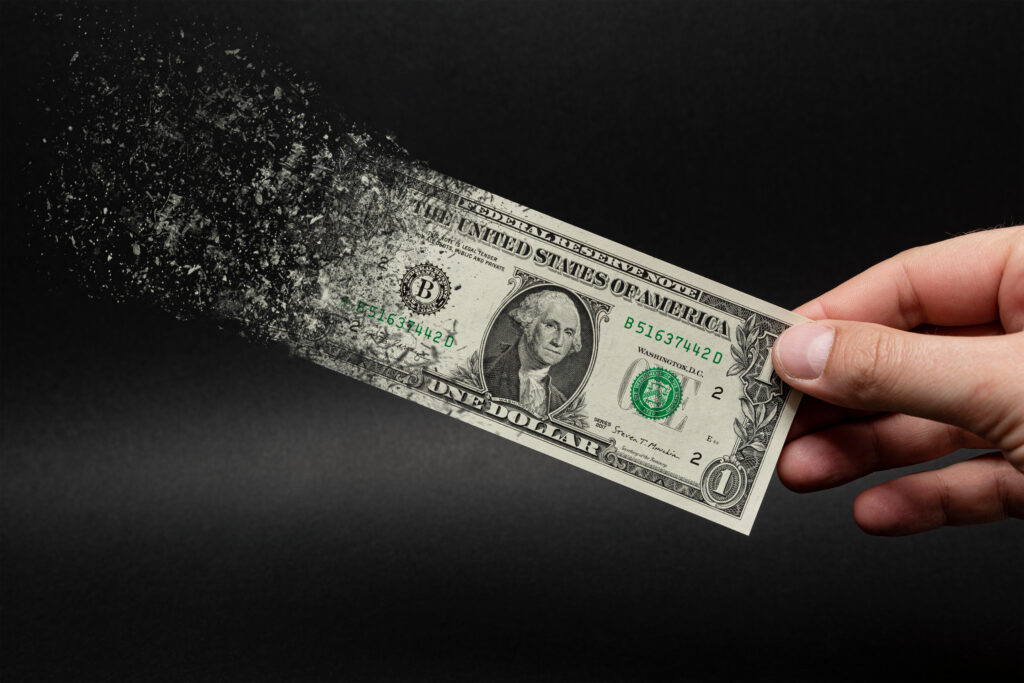A healthy allocation to Big Pharma stocks and early stage Biotech stocks should ward off the ills of inflation for most portfolios.
It’s here. Like a circle of acned teenagers in a horror movie, summoning a demon through magical incantations they don’t respect and don’t understand, the Fed’s incessant money printing (at least $3.8 Trillion in just one year) has finally torn open the gates of inflation hell. After all kinds of soothing assurances that massive money printing simply couldn’t cause inflation to flail out of control (“We know what we’re doing….) this week the FED was forced to announce that annualized inflation has now hit 6.2%, the worst in at least three decades.
And this is just the inflation that shows up under CPI, the FED’s very questionable method for measuring inflation. Many average citizens have pointed out that rents have increased anywhere between 10 and 40% in major urban areas. Reliable, independent economic observers believe inflation could go much higher from here. We have definitely hit the point in the horror movie where the reckless teens finally realize what they have done, and the demon is now threatening their very existence.
There isn’t much that an individual investor can do about the Federal Government’s decision to debase the world’s reserve currency, and it’s seeming determination to keep spending no matter what. However, we know from thousands of years of economic history, that in times of inflation, many workers get very poor, but a few select investors get very rich. How can we make sure that you are in the second group?
Some assets will do better in a long term inflationary environment than others. What will do terrible is wages. History shows, again and again, that wages just can’t keep up with runaway inflation. We believe that the right mix of healthcare assets will actually thrive in an inflationary environment. Specifically, we prefer a “barbell” approach, dividing assets into two distinct, separated categories, and avoiding most of the assets that fall somewhere in between. We believe that a “barbell” shaped portfolio, consisting of large cap, dividend producing Big Pharma stocks on one end, and early stage, pre-revenue biotech on the other end, will help you defeat the demon of inflation.
Why Big Pharma?
There are a few simple reasons why Big Pharma has a great chance of weathering the inflationary storm. First and foremost, they have done it before. In fact, they have done it many times.
One strange phenomena that we are facing is a lack of experience as we confront the oncoming inflation crisis. The last time we saw this kind of broad, poorly controlled inflation was the early 80’s. That’s 40 years ago! How many financial professionals are out there who still remember, in detail, everything that happened 40 years ago?
There may not be that many people, but there are plenty of big organizations who have survived many of these kinds of crises. If you think 40 years feels like a long time gone in the fast paced world of big business, how about 140 years? Many big pharma concerns have thrived for that long, or even longer! They have survived multiple world wars, depressions, inflation, deflation, reflation…..you get the idea. Companies like Pfizer ($PFE), Eli Lilly ($LLY) and Johnson & Johnson ($JNJ) have slain many economic demons over the decades. Reason suggests they won’t have any trouble this time, either.
So we can clearly see that Big Pharma has done just fine in past inflationary environments. Why might that be? There are a few clear-cut reasons.
The first reason is that, despite a lack of bricks & mortar, Big Pharma is really in the real estate business. Everyone knows that real estate traditionally does well in inflationary environments. Big Pharma is actually in real estate, too. Except their real estate is intellectual real estate. They own property just like other real estate funds, except that their property is intellectual property.
Intellectual property has a surprising amount in common with property property. Specifically, both physical property and intellectual property represent a fixed investment. If I buy an apartment building for $10M, then my cost was $10M. As time goes by and inflation rages, I can raise my rents right along with inflation. However, my fixed investment remains the same. Essentially inflation makes my fixed costs less and less, while greatly increasing my revenues year after year. The same is mostly true for the intellectual property that Big Pharma owns.
For example, let’s say Big Pharma Corp, invests $5 billion dollars to develop a certain cancer drug. That’s a lot of money, even for Big Pharma Corp. However, once they have graduated from the “sowing” phase, and move into the “reaping” phase, their hard costs are mostly locked in (the cost of a drug is mostly in developing it; once it goes to market, it typically costs pennies to manufacture). Typically drugs have twenty years of patent exclusivity when they can charge whatever the market will bear. So, each year Big Pharma Corp sets a new price for it’s cancer drug, just like a landlord can increase her rents each year. If inflation settles in at 7%, that would mean that the price of the drug could double every ten years. At the end of the patent exclusivity period, Big Pharma Corp could easily be charging 4 times the drug’s initial price. This is why many large pharmaceutical firms have earned the title of “dividend aristocrat.” Due to this pricing structure, it’s been easy for large cap pharma companies to meet or beat inflation every year with their divided raises, for decades on end.
The other reason why Big Pharma will inevitably mint money, even in a new age of inflation, is their strong and deep connections to the US Congress. As the saying goes, “it’s not what you know, but who you know.” Current efforts at containing the profitability of Big Pharma are instructive. As I write this post, efforts at pharmaceutical price reform are going in circles, and clauses that would have triggered material harm to Big Pharma’s bottom line seem to be fading away. In a worst case scenario, senators are discussing passing legislation that would limit pharmaceutical price hikes to the rate of inflation. That means that, if inflation is at 5%, Big Pharma can raise prices 5%. If inflation is at 15%, then Big Pharma can raise prices 15%. In the worst case scenario, Big Pharma is legally guaranteed that they can keep up with inflation.
I challenge you to find another industry with better inflation protection!
Why Early Stage Biotech?
So we can see above that the biggest reason to recommend Big Pharma stocks in the face of stiff inflation is that Big Pharma’s revenue increases are virtually guaranteed. So why on earth would I favor a group of small stocks with no revenue at all?
Simply put, early stage, pre-revenue, biotech companies derive their stock market value from what analysts, pundits and investors, guess the revenue potential will be. If there is no revenue yet, then the value of the company is based on what people guess the potential is. If inflation comes in at a 10% annual clip, then those “revenue guesses” can simply be adjusted up by 10%. It’s all imaginary money anyhow!
Let’s go back to the example above, whereby Big Pharma Corp invests $5 billion to launch a new cancer drug. It’s very likely that a large portion of that $5 billion dollar investment actually came in the form of a buyout deal. Big Pharma rarely innovates anything these days; typically Big Pharma just swallows small pharma companies whole. They then bring the former small pharma’s innovations to market.
Now let’s say that a theoretical “Small Pharma Corp” is developing a novel method of attacking cancer. They have produced promising data, and filed some patents, but they haven’t sold a single drop of the stuff, yet. Believe it or not, today’s stock market is filled with embryonic publicly traded companies just like Small Pharma Corp. You are thinking about investing, so you look up the company’s ticker, and see that this tiny company with no revenue is currently valued at $2 billion dollars. $2 Billion, with nine zeros!
How did anyone come to this crazy valuation? Well, there are two prevailing methods. The first method is, analysts are going to look at the data that Small Pharma Corp is producing, and compare “what could be” to the current, real world revenues of comparable (or mostly comparable) cancer drugs. Many cancer drugs on the market today easily produce $1 Billion in revenue each year. Based on that fact, valuing Small Pharma Corp, with it’s promising data from early clinical studies, at $2 Billion is not a stretch at all. Early stage biotech companies are inflation fighters because their stock market valuation is tied to the “going price” of drugs that are currently on the market. If those “going prices” skyrocket due to general inflation, then so will the fair estimate of the value of the biotech.
The second way that small, pre-revenue companies wind up with big valuations is simply to compare them to other companies that have recently been bought out. Remember our example with Big Pharma Corp, whereby a large part of it’s $5 billion investment in it’s new cancer drug was actually the acquisition price of a smaller biotech? This happens dozens of times each year. Large pharmaceutical corporations are acquisition machines. In an inflationary environment, these acquisition prices will simply go up with the general rate of inflation. If inflation comes in at 5%, then Big Pharma Corp will need to pay 5% more. If inflation comes in at 15%, then Big Pharma Corp will need to pay 15% more to acquire the small biotech and it’s promising intellectual property. If, in our example, Small Pharma Corp, has several comparable rivals that have been acquired for $2 billion, then it would be reasonable to think that they have a similar market value. If inflation takes off, and those comparable rivals get purchased for $2.5 billion, then Small Pharma Corp’s value just went up. That is how we beat inflation.
What are some examples of small, pre-revenue biotech companies that could do well in a long term inflationary environment? Caribou biosciences ($CRBU), Morphic Holdings ($MORF) and Kronos Bio ($KRON) are all examples.
History shows that inflation can be tough to shove back in the cage once the beast has broken loose. Many wage earners will suffer, and those who hold the wrong assets could see their wealth fade away. However, if you focus your holdings on companies that can raise prices at or beyond the rate of inflation, your portfolio should remain the picture of health.
DISCLOSURE: The Sick Economist owns shares of Eli Lilly and Caribou Biosciences.








Hi,
Very interesting article. If you had time would you be able to do a rough valuation of $lbps #dddd. 4d pharmaceuticals.
http://www.4dpharmaplc.com/en/developing-science/pipeline
They have an extensive pipeline, with strong ties to Merck.
If you haven’t seen this bio well worth a look, sp low due to distressed seller.
Many thanks
Chris
Hi Chris:
You inspired me to take a quick look at 4D. It does seem like they are working on some interesting things over there, but I wonder about their financial strength. Their cash runway seems modest, they have a long way to go before they will have viable commercial products, and, in today’s new “biotech crash” world, suddenly it may be a lot tougher to raise new funding.